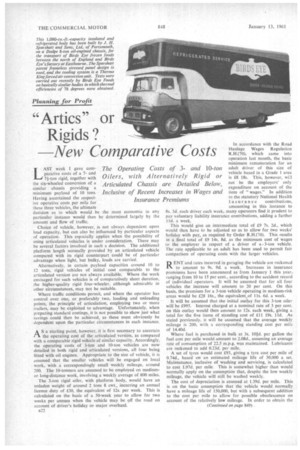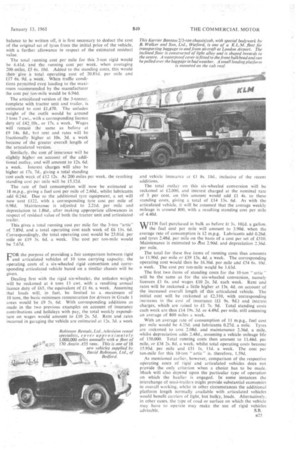"Artics" or Rigids ?
Page 104

Page 107

If you've noticed an error in this article please click here to report it so we can fix it.
New Comparative Costs LAST week I gave comparative costs of a 7and
7+-ton rigid, together with the six-wheeled conversion of a similar chassis providing a minimum payload of 10 tons. • Having ascertained the respective operative costs per mile for these three vehicles, the ultimate decision as to which would be the most economic in any particular instance would then be determined largely by the amount and flow of traffic.
Choice of vehicle, however, is not always dependent upon load capacity, but can also be influenced by particular aspects of operation. This espcially applies when the possibility of using articulated vehicles is under consideration. There may be several factors involved in such a decision. The additional platform length normally provided by an articulated vehicle compared with its rigid counterpart could be of particular advantage when light, but bulky, loads are carried.
Alternatively, in certain payload capacities around 10 to 12 tons, rigid vehicles of initial cost comparable to the articulated version are not always available. Where the work envisaged for such vehicles is of comparatively short duration, the higher-quality rigid four-wheeler, although admirable in other circumstances, may not be suitable.
Where traffic conditions permit, and where the operator has control over one, or preferably two, loading and unloading points, the principle of articulation, employing two or more trailers, may be exploited to advantage. Unfortunately, when preparing standard costings, it is not possible to show just what savings could then be achieved, as these must obviously be dependent upon the particular circumstances in each instance.
AS a starting point, however, it is first necessary to ascertain the operating cost of the articulated version, as compared with a comparable rigid vehicle of similar capacity. Accordingly, the operating costs of 3-ton and 10-ton vehicles are now detailed in both rigid and articulated versions, all four being fitted with oil engines. Appropriate to the size of vehicle, it is assumed that the smaller vehicles will be engaged on local work, with a correspondingly small weekly mileage, around 200. The 10-tonners are assumed to be employed on mediumor long-distance work, involving a weekly average of 800 miles.
The 3-ton rigid oiler, with platform body, would have an unladen weight of around 2 tons 8 cwt., incurring an annual licence duty of £30, the equivalent of 12s. per week. This is calculated on the basis of a 50-week year to allow for two weeks per annum when the vehicle may be off the road on account of driver's holiday or major overhaul.
B22 In accordance with the Road Haulage Wages Regulation R.H.(70), which came into operation last month, the basic minimum remuneration for an adult driver of this size of vehicle based in a Grade 1 area is £8 18s. This, however, will not be the employers' only expenditure on account of the item of "wages." In addition to the statutory National Health In sur anc e contributions, amounting in this instance to 8s. 3d. each driver each week, many operators find it prudent to pay voluntary liability insurance contributions, adding a further 11d, a week.
This would give an intermediate total of £9 7s. 2d., which would then have to be adjusted so as to allow for two weeks' holiday with pay, as required by Order 12,14.(70). This results in a final total of £9 14s. 8d, as the minimum cost of wages to the employer in respect of a driver of a • 3-ton vehicle. The rate applicable to an adult has been used to permit fair comparison of operating costs with the larger vehicles.
RENT and rates incurred in garaging the vehicle are reckoned to amount to 9s. 9d. a week. Increases in insurance premiums have been announced as from January 1 this year; ranging from 10 to 15 per cent., according to the accident record of individual operators. It will be assumed that for all four vehicles the increase will amount to 20 per cent. On this basis, the premium for a 3-ton vehicle operating in medium-risk areas would be £28 16s., the equivalent of Ils. 6d. a week.
It will be assumed that the initial odlay• for this 3-ton oiler will be £995. Interest charged at a nominal rate of 3 per cent. on this outlay would then amount to 12s. each week, giving a total for the five items of standing cost of £11 19s. 11d. As stated previously, it will be assumed that the average weekly mileage is 200, with a corresponding standing cost per mile of 14.40d.
Where fuel is purchased in bulk at 3s. 101d. per gallon the fuel cost per mile would amount to 2.08d., assuming an average rate of consumption of 22.5 m.p.g. was maintained. Lubricants are reckoned to add 0.23d. per mile.
A set of tyres would cost £93, giving a tyre cost per mile of 0.74d., based on an estimated mileage life of 30,000 a set. Maintenance, inclusive of washing and servicing, is calculated to cost 1.97d. per mile. This is somewhat higher than would normally apply on the assumption that, despite the low weekly mileage, the vehicle will still be washed weekly.
The cost of depreciation is assessed at 1.39d. per mile. This is on the basic assumption that the vehicle would normally have a mileage life of 150,000, but with a subsequent addition to the cost per mile to allow for possible obsolescence on account of the relatively low mileage. In order to obtain the balance to be written off, it is first necessary to deduct the cost of the original set of tyres from the initial price of the vehicle,. with a further, allowance in respect of the estimated residual value.
The total running cost per mile for this 3-ton rigid would be 6.41(.1 and the running cost per week, when averaging 200 miles, £25 6s. 10d. Added to, the standing costs, this would then give a total operating cost of 20.81d. per mile and £17 61.'9d. a week. When traffic conditions permitted eveu loading to the maximum recommended by the manufacturer the cost per ion-mile would be 6.94d.
The articulated-version of the 3-tonncr, complete with tractor unit and trailer, is estimated to cost £1,470. The unladen weight of the Outfit would be around 3 tons 7 cwt., with a corresponding licence duty of £42 Os, or 17s. a week. Wages will remain the same as before at £9 14s. 8d,, but rent and rates will be fractionally, higher at 10s. 3d. a week because of the greater overall length of the articulated version.
Similarly, the cOst of insurance will he slightly higher on account of the additional outlay, and will amount to 12s. 6d. a week. Interest charges will also be higher at 17s. 7d., giving a total standing cost each week of #112 12s. At 200 miles per week, the resulting standing cost per mile will be 15.12(1.
The rate of fuel consumption will now be estimated at 18 m.p.g., giving a fuel cost per mile of 2.60d., whilst lubricants add .0.24(1. Due to the additional tyre equipment, a set will now -cost £122, with a corresponding tyre cost per mile of 0.98d. Maintenanae is adjusted to 2.21d. per mile and depreciation to 1.86d., after making appropriate allowances in respect of residual value of both the tractor unit and articulated trailer.
This gives a .total running cost per mile for the 3-ton "artic" of 7.89d. and a total operating cost each week of £6 11s, 6d. Correspondingly, the total operating cost would be 23.0Id. per mile or £19 3s. 6d. a week. The cost per ton-mile would be 7.67d.
FOR the purpose of providing a fair comparison between rigid and articulated vehicles of 10 torts carrying capacity. the operating costs of a six-wheeled rigid converSion and corresponding articulated vehicle based on a similar chassis will be given.
Dealing first with the rigid six-wheeler, the .unladen weight will be reckoned at 4 tons 13 cwt. with a resulting annual licence duty of £65, the equivalent of El 6s. a week. Assuming that loads will, in fact, be limited to a maximum of 10 tons, the basic minimum remuneration for drivers in Grade I areas would be £9 5s. 6c1-. With corresponding additions as made in the two previous examples on account of insurance contributions and holidays with pay, the total weekly expenditure on wages would amount to £10 2s. 5d. Rent and rates incurred in garaging the vehicle are estimated at 12s. 3d. a week
and vehicle insurance at LI 8s. 10d., inclusive of the recent additions.
The total outlay on this six-wheeled conversion will be reckoned at £2,000, and interest charged at the nominal -rate of 3 per cent. on this amount would add £1 4s. to these standing costs, giving a total of £14 I3s. 6d. As with the articulated vehicle, it will be assumed that the average weekly mileage is around 800, with a resulting standing cost per mile
. of 4.40d.
WITH fuel purchased in bulk as before ftt 3s. 14.4d. a gallon. F! the fuel cost per mile will amount to 3.90d. when the average rate of consumption is 12 m.p.g. Lubricants add 0.26d. and tyres 2.48d. per mile on the basis of a cost per set of £310. Maintenance is estimated to ebst 2.90d. and depreciation 2.36d. per mile.
The total for these five items of running costs thus amounts to 11.90d. per mile or £39 13s, 4d. a week. The corresponding operating cost would then be 16.30d. per mile and £54 6s. 10d. a week. The cost per ton-mile would be .1.63d.
The first two items of standing costs for the 10-ton " artic " will be the same as for the six-wheeled conversion, namely licences £1 6s. and wages £10 2s. 54. each week. Rent and rates will be reckoned a little higher at 13s. 4d. on account of the increased overall length of this articulated vehicle. The initial cost will be reckoned at £2,310, with corresponding increases in the cost of insurance (£1 9s. 9d.) and, interest charges, which are raised to £1 7s. 9d. Total standing costs each week are thus £14 19s. 3d. or 449d. per mile, still assuming an average of 800 miles a week.
With an average rate of consumption of 11 m.p.g., fuel cost per mile would be 4.25d. and lubricants. 0.27d. a mile. Tyres are reckoned to cost 2.08d. and maintenance 2,36d. a mile, whilst depreciation adds 2.48d., assuming a vehicle mileage life of 150,000. Total running costs then amount to 11.44d. per mile, or £38 2s. 8d, a week, whilst total operating costs become 15.93d. per mile and £51 ls, lid, a week. The cost per ton-mile for this 10-ton " artic " is, therefore, 1.59d.
As mentioned earlier, however, comparison of the respective operating costs of rigid and • articulated vehicles does not provide the only criterion when a choice has to be made. Much will also depend upon the particular type of operation on which the haulier is engaged. In some instances the interchange of semi-trailers might provide substantial economies in overall working, whilst in other cirdurnstances the additional platform length normally available with articulated vehicles would benefit carriers of light, but bulky, loads. Alternatively. in other cases, the type of road or surface on which the vehicle may have to operate may make the use of rigid vehicles advisable. S.B.




















































































































































